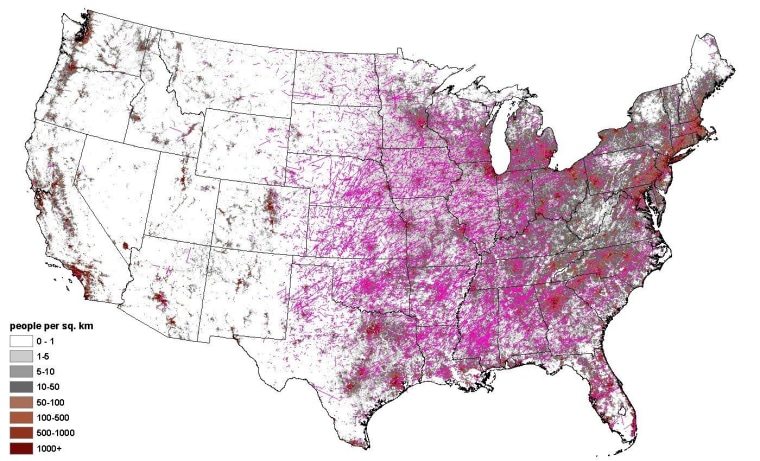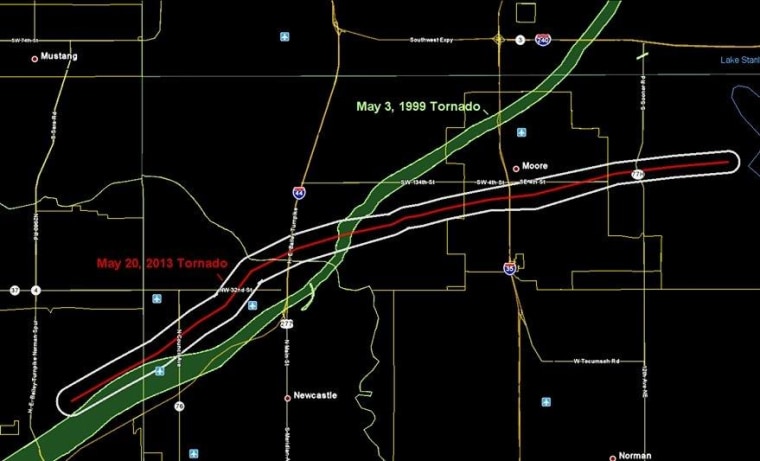Do tornadoes follow well-worn tracks? Where do the deadliest twisters hit? Will climate change make such storms worse? Monday's devastating tornado in Oklahoma raises some questions for which scientists have ready answers, and others that could puzzle them for years to come:
Was this tornado a repeat of a famous twister in 1999?
For a time, Monday's storm followed a track that was similar to the path of a tornado with the fastest wind speed ever recorded, 318 mph (512 kilometers per hour), which occurred on May 3, 1999. That twister was one of 74 tornadoes that touched down in Oklahoma and Kansas in less than 21 hours, according to the National Severe Storms Laboratory. The 1999 outbreak of severe weather caused 46 deaths and nearly $1.5 billion in property damage.
The tracks weren't all that similar, however: Monday's tornado took a more southerly route as it moved east. And there's nothing unique about the area's geography to make it a magnet for super-powerful twisters, according to Bob Henson of the National Center for Atmospheric Research in Boulder, Colo.
"If there were geographic features, that would tend to cause multiple tornadoes every few years," the meteorologist and writer told NBC News. "Well, why has this been happening only since 1999?"
The similarity in the tracks of these devastating storms is "a good example for how weather events can be clustered in ways that are striking yet ultimately coincidental," Henson said.
A classic example of this phenomenon, he noted, is Codell, Kan., which was hit by tornadoes on the same day — May 20 — in 1916, 1917, and 1918. The third tornado killed 10 people and destroyed a part of the community. "That's a good illustration of how sometimes things like this can just happen in clusters," he said.

But isn't Tornado Alley more prone to deadly twisters?
On a wider scale, the geography of America's midsection makes it more prone to tornadoes than any other region on Earth. The classic explanation is that the Rocky Mountains tend to impede the eastward flow of moist air, while the Great Plains allow frigid air to stream southward from Canada and meet up with warm, humid air from the Gulf of Mexico. However, the National Weather Service's Storm Prediction Center says this is a "gross oversimplification" for the origin of tornadoes.
Cliff Mass, a weather researcher at the University of Washington, cites an array of factors that include strong vertical instabiliity and a large amount of wind shear during the spring. "It turns out that nearly every geographical and meteorological aspect conducive to severe convection comes together here," Mass wrote in an explanatory blog posting this week.
"Tornado Alley" generally refers to the region centered in Texas, Oklahoma, Kansas and points north, where tornadoes are most frequent — but multiplestudies indicate that the deadliest twisters occur to the east, in a region that's come to be known as "Dixie Alley." The reasons for that have to do with geography and demographics as well as meteorology in the southeastern United States: Storms tend to move faster, and they're more likely to strike at night. There are more trees and other obstructions to raise havoc. Population densities are generally higher, and the region has many manufactured homes that lack basements in which to take shelter.
The United States has the highest incidence of tornadoes, with an average of more than 1,000 every year, according to the National Climatic Data Center. But other regions of the world have twisters as well. Canada is No. 2 with about 100 per year, followed by northern Europe, western Asia, Bangladesh, Japan, Australia, New Zealand, China, South Africa and Argentina. Britain has more tornadoes than any other country, relative to its land area. "Fortunately, most UK tornadoes are relatively weak," the data center says.
Why do these tornadoes seem to be hitting all of a sudden?
After a relatively quiet start to the tornado season, tornadoes have been erupting from Texas to Minnesota over the past week. A cold front advancing to the east appears to be to blame. That pocket of cold air ran into warm air from the Gulf, causing the warm air to rise and spawning powerful thunderstorms. "It's kind of like the perfect setup," Jeff Weber, a scientist with the University Corporation for Atmospheric Research, told LiveScience.
The earlier calm was due to the fact that jet stream had been dipping farther south than usual for this time of year. That kept the Gulf's warm, moist air from advancing into Tornado Alley early in the tornado season.
Will climate change make tornadoes worse? More frequent?
"The short answer is, we have no idea," Michael Wehner, a climate researcher at the Lawrence Berkeley National Laboratory, told NBC News. For years, Wehner has been studying the climate models for extreme weather, and he's a lead author for the next report from the Intergovernmental Panel on Climate Change as well as the federal government's latest national assessment on climate change.
One problem is that the observational record for tornadoes has not been uniform over time. "It has a bias to it, because more people are living where tornadoes occur, and more people are out looking for them," Wehner said. That contributes to the perception that tornadoes are happening more frequently than they used to.
The other big problem is that current climate models don't have the resolution that's needed to simulate the localized, violent activity of a tornado. Currently, global models are built up from atmospheric interactions on a scale of 100 kilometers (62 miles). Improvements in computer power could soon bring that down to a scale of 25 kilometers (16 miles). That should make it possible for scientists to simulate the weather phenomena that give rise to tornadoes, but not the tornadoes themselves, Wehner said.
On a larger scale, extreme weather events are expected to become more frequent in a warmer world, Wehner said. "The metric that I like to look at is the daily amount of rain for a storm that happens once every 20 years," he said. "That storm, in a much warmer world, would happen more frequently." For example, if the world follows a "business-as-usual" scenario, he projects that the average temperature would rise 11 degrees Fahrenheit (6 degrees Celsius) by the end of the century, and that a once-in-20-years rainstorm would come around every five to 10 years on average.
That doesn't necessarily mean tornadoes would be more frequent, however. In fact, the current projection calls for wetter spring weather in the northern U.S., and drier weather in the Southwest — with Tornado Alley right in the middle. "There's some evidence that there might not be a change" in the character of a tornado season, Wehner observed.
Wehner may sound a bit apologetic about the lack of clear answers in the short term, but in the long term, he's optimistic. "The reason I'm optimistic that we can get somewhere on this is that supercomputing technology is driving this very hard," he said. "We're just getting into the sweet spot for these kinds of issues, with the largest mainframes that money can buy."
Update for 1:50 p.m. ET May 24: We've revised the explanation of the factors behind Tornado Alley's susceptibility to twisters, so that it includes a more nuanced view from the University of Washington's Cliff Mass.
More about tornado science:
- Why tornadoes seem as if they're on the rise
- Flash interactive: What causes tornadoes?
- Full coverage of the Oklahoma tornadoes
Alan Boyle is NBCNews.com's science editor. Connect with him by "liking" the NBC News Science Facebook page, following @b0yle on Twitter and adding him to your Google+ circles.
John Roach is a contributing writer for NBC News. To learn more about him, visit his website.
